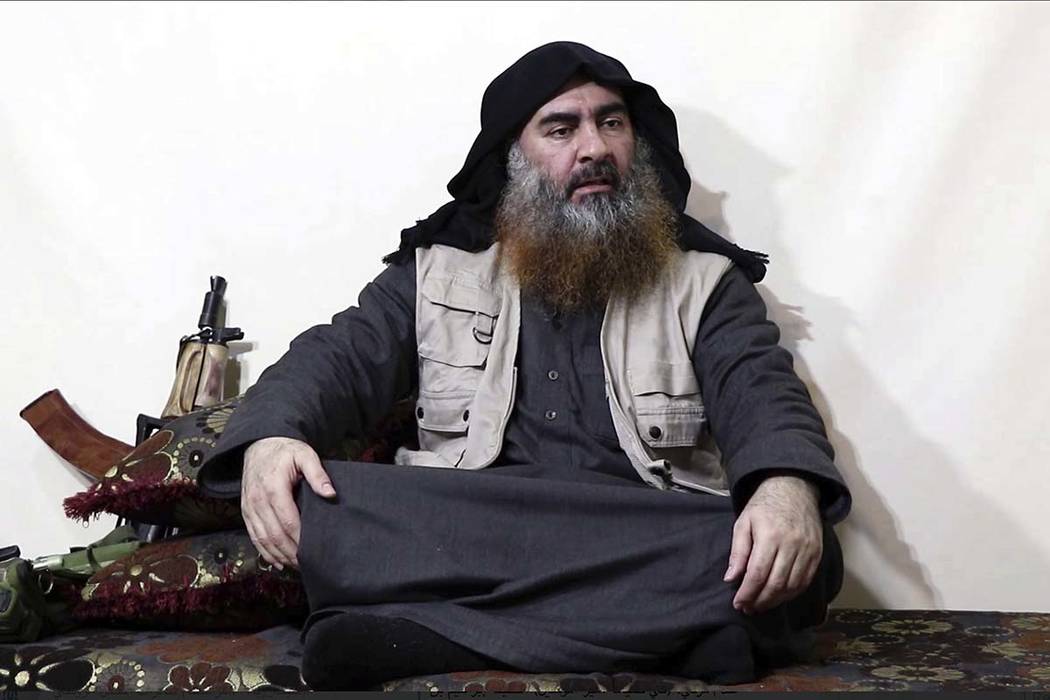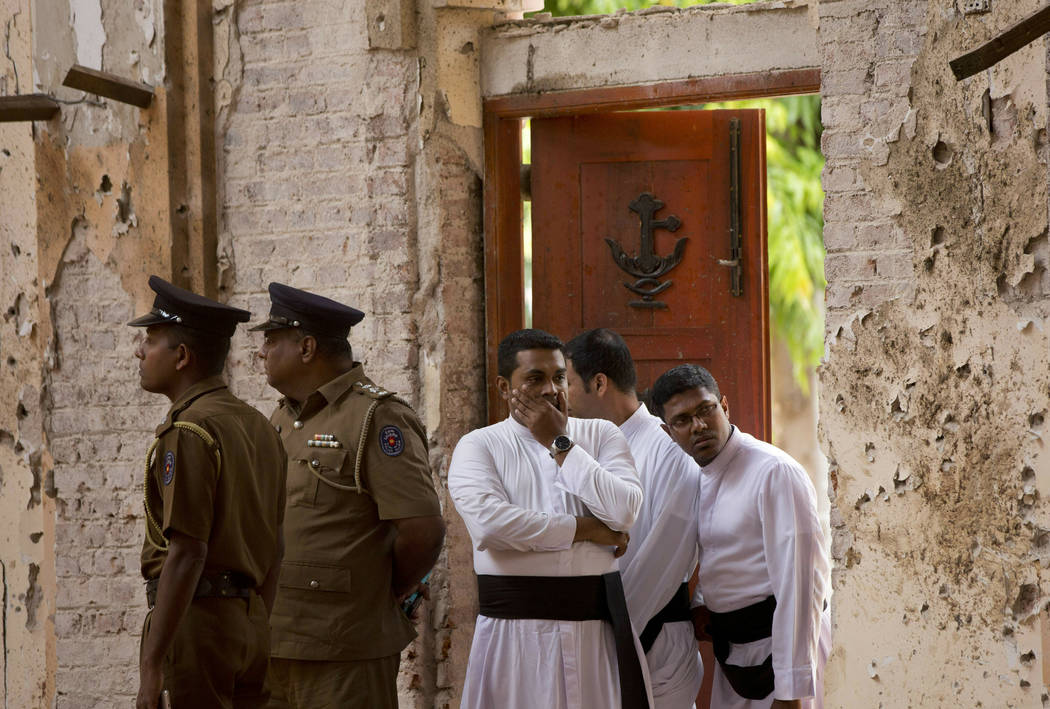ISIS leader defines ‘war of attrition’ for group after caliphate
COLOMBO, Sri Lanka — No longer burdened by territory and administration, Islamic State group leader Abu Bakr al-Baghdadi outlined the new path forward for his group: Widen your reach, connect with far-flung militant groups and exhaust your enemies with a “war of attrition.”
The deadly Easter attacks in Sri Lanka a week before his video appearance underscored this message in blood. It also highlighted the ease with which IS, like al-Qaida before it, can inflict chaos through a loosely defined brand of global jihad in the most chilling way. That’s even after losing the relative safety of its so-called caliphate across stretches of Iraq and Syria.
“Al-Baghdadi was letting his followers know that he was prepared to lead a guerrilla insurgency in Iraq and Syria, while not forgetting that ISIS is a global organization,” said Colin P. Clarke, a senior research fellow at the Soufan Center, using another acronym for the group.
Though disheveled and never standing up in the video released Monday, al-Baghdadi’s appearance alone contradicted past Russian and Iraqi claims the militant leader had been killed during the long war targeting the militants. It was the first time he has appeared in public since June 29, 2014, when he delivered a sermon from the pulpit of Mosul’s Great Mosque of al-Nuri.
Major image change
The contrasts in the appearances are glaring.
In 2014, he wore an expensive-looking watch and a neatly trimmed beard and urged Muslims around the world to swear allegiance to the group’s self-proclaimed caliphate and obey him as its leader.
In Monday’s video, he sat on the floor, with an AK-74 assault rifle at his side like the one Osama bin Laden took in Afghanistan during the mujahedeen’s fight against the Soviets and always carried with him. He had a big bushy beard and wore a black tunic and a military-style beige vest over it.
No longer an administrator, al-Baghdadi wants to be seen as an insurgent leader. Analysts say that both glosses over the loss of territory the militants claimed would spark an apocalyptic confrontation with the “crusader” West and ensures he maintains his status in the extremist world.
“We believe it is really an attempt to divert attention from the core group’s heavy losses and to ensure that the franchise groups and grassroots supporters remain loyal to the Islamic State pole of the jihadist universe,” the Austin, Texas-based private intelligence firm Stratfor said in an analysis. “Many are saying that the video is a show of strength, but we believe it is more likely an act of desperation.”
The loss of its territory cuts both ways, however. Foreign militants once part of the “caliphate” now have scattered, like they did at the end of the 1980s war against the Soviets in Afghanistan and after the 2001 U.S.-led invasion that toppled the Taliban government sheltering al-Qaida.
Al-Baghdadi barely mentioned Iraq and Syria in the 18-minute video, except to praise the steadfastness of his fighters there. Instead, he congratulated militants in Libya, “brothers” in Burkina Faso, Mali, Pakistan and the Western Sahara for pledging allegiance.
Many attack claims
The group also recently claimed numerous attacks around the world, including in Saudi Arabia, Congo and Libya. Jihadi propaganda by IS supporters online recently threatened India and Bangladesh, where IS claimed an attack for the first time in some two years this week.
While some IS claims of late have been exaggerated or outright bogus, its focus on expanding outward follows the same pattern of al-Qaida, which grew to have dangerous franchises in areas like Yemen.
“This is part of the vengeance that awaits the crusaders and their henchmen,” al-Baghdadi said in the video.
He extolled militants in Sri Lanka for “striking the homes of the crusaders in their Easter, in vengeance for their brothers in Baghouz,” a reference to the Islamic State group’s last bastion in eastern Syria, which was captured by U.S.-backed fighters in March. The militants involved in the attacks that killed more than 250 people followed a local extremist leader, but more than 30 Sri Lankans are believed to have once been Islamic State fighters in Syria and Iraq.
“It is still unclear if any of the Sri Lanka terrorists had fought for ISIS in Syria and Iraq and were returnees, or if they were locally trained and linked up with ISIS online,” an analysis from the Asia-Pacific Foundation said. “What we are witnessing has been an evolving terrorist dynamic where an attack is developed and conceived abroad but that local radicals are recruited to implement the final stage.”
Simply put: The new threat from the Islamic State is a lot like the old threat, except the group doesn’t have a home address anymore. For years, the group’s leaders huddled in IS-held cities in Iraq and Syria to plot attacks abroad, even as they terrorized residents at home.
Attacks closer to home
Now mass casualty assaults like the 2015 attacks on the Bataclan theater in Paris may be planned much closer to local militants’ homes, like the Easter attack in Sri Lanka. One of the churches hit was just a town from where the alleged leader of that assault preached his extremist message.
That has been the case in the southern Philippines, where al-Baghdadi’s group has set its eyes on latching on to local insurgencies or remotely executing plots it has financed, such as a massive siege of the Muslim-majority city of Marawi. Hundreds of IS-aligned local militants occupied buildings, homes and school campuses there in May 2017.
It took Filipino troops five months to quell the urban insurrection, which was reportedly patterned after the IS takeover of the northern Iraqi city of Mosul.
IS-aligned militants are also accused of carrying out two suicide attacks in the southern Philippines, including the Jan. 27 suicide bombing of a Roman Catholic cathedral during a Mass that killed 23.
That’s led to a monthslong counterinsurgency operation that Philippine Interior Secretary Eduardo Ano said has contained the militants.
For how long remains the question.
“Intensive military operations may weaken these groups temporarily, but airstrikes and killings only reinforce the narrative of state oppression in a way that serves the ideological cause,” said Sidney Jones, director of the Jakarta-based Institute for Policy Analysis of Conflict.
As the holy fasting month of Ramadan begins in just days, experts warn there could be even more attacks looming.
“Our battle today is one of attrition and stretching the enemy. They should know that jihad is ongoing until the day of judgment,” al-Baghdadi said.
———
Karam reported from Beirut. Associated Press writer Jim Gomez in Manila, Philippines, contributed to this report.





















